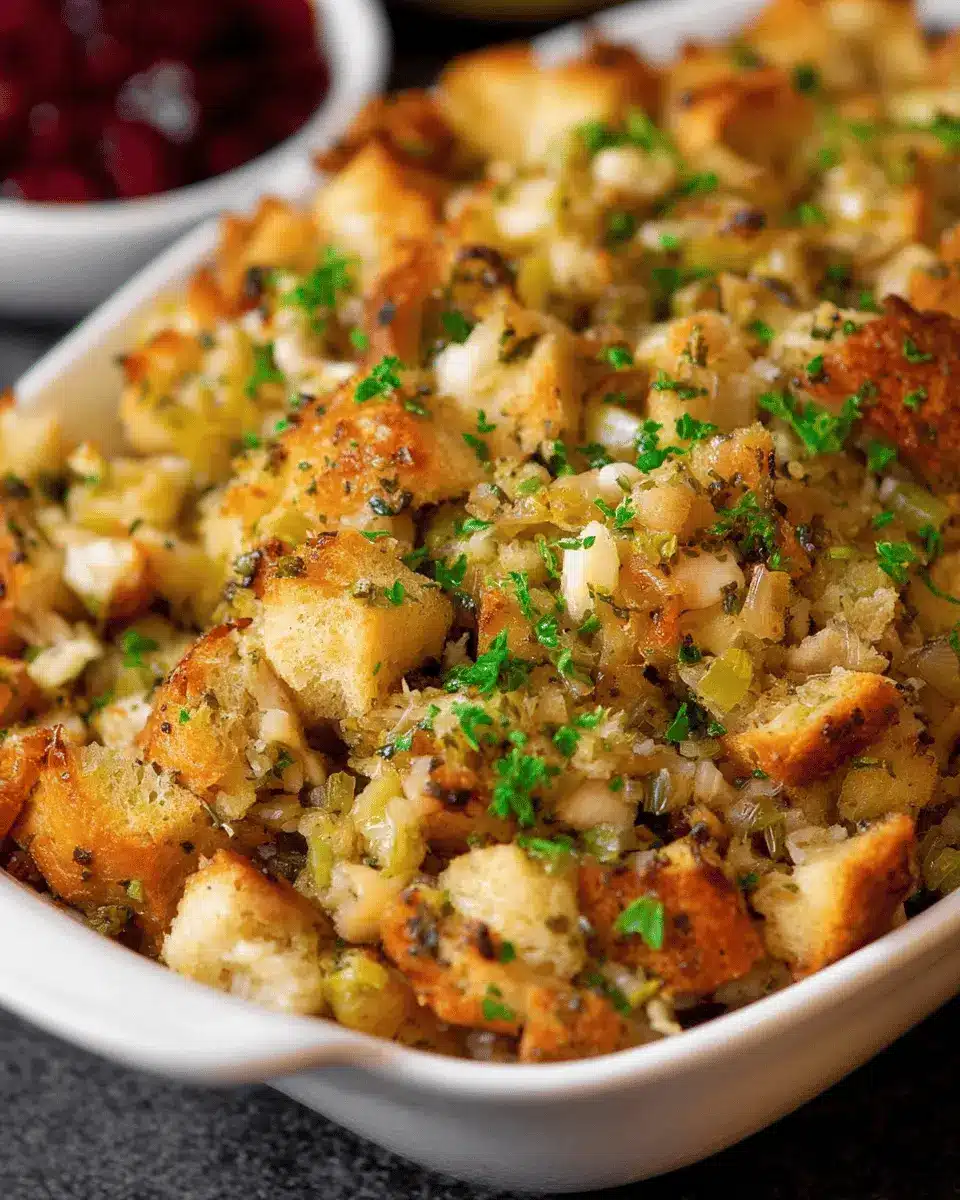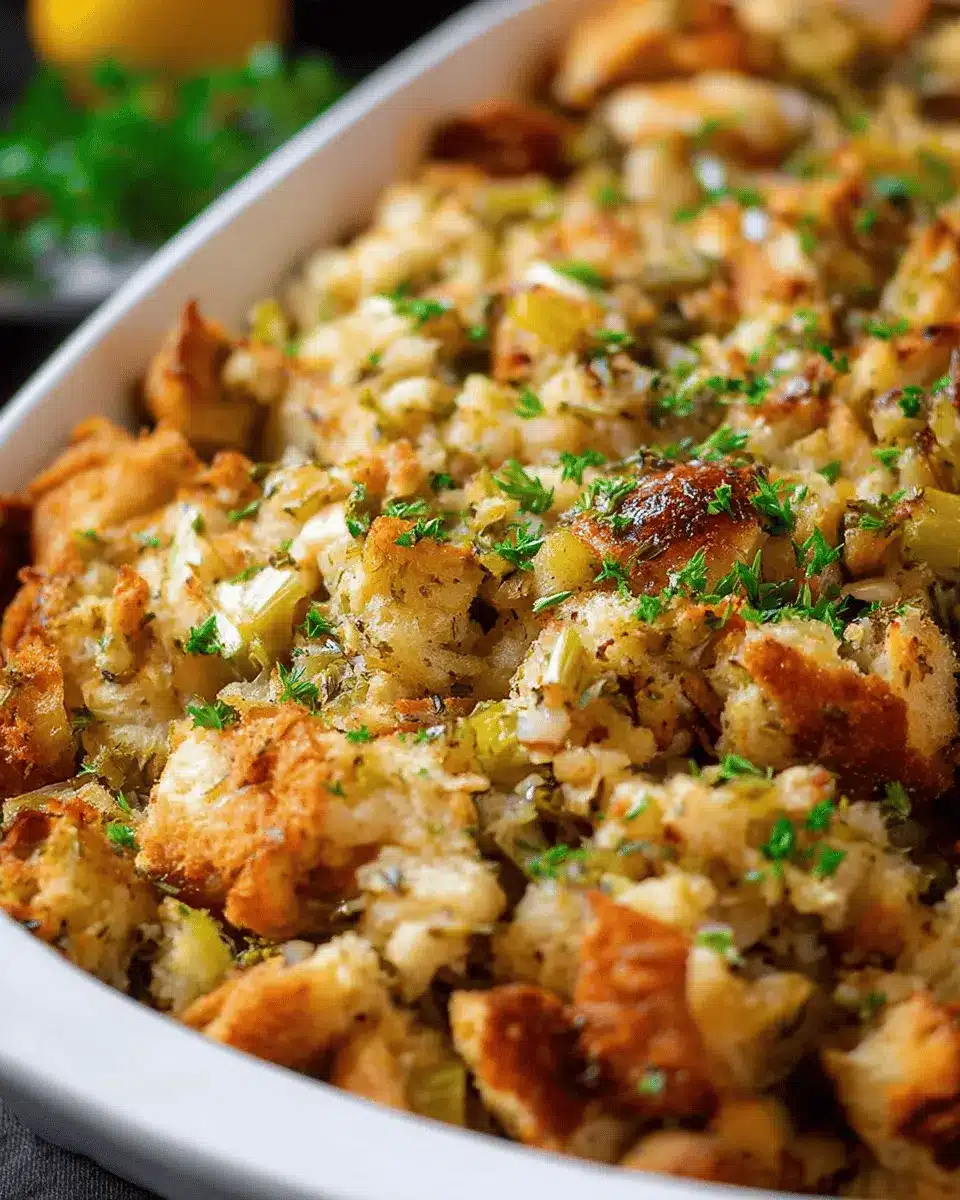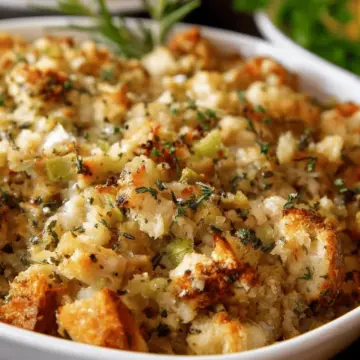Introduction to Turkey Stuffing
Thanksgiving wouldn’t be complete without Turkey Stuffing. This beloved dish has a way of capturing the essence of the holiday, bringing together family and friends around a shared table. But why is stuffing such a must-have for your Thanksgiving spread?
First off, the delightful aroma that wafts through your home as it bakes is simply irresistible. The combination of toasted bread, aromatic herbs like sage and thyme, and savory vegetables creates a symphony of flavors that not only enhances the turkey but elevates the entire meal. According to a survey from the American Farm Bureau, more than 70% of families consider stuffing one of their top three Thanksgiving staples — a testament to its popularity!
Moreover, Turkey Stuffing is incredibly versatile. You can easily customize it to suit various dietary needs or preferences, adding extras like Turkey Bacon for a smoky twist or even swapping in some vegetables for a vegetarian version. The best part? It’s a no-fuss side that complements not just turkey but also Chicken Ham and Beef, shining brightly amid the feast.
Want to impress your guests this year? Then keep reading for an easy, delectable recipe that’s bound to become a family favorite!

Ingredients for Turkey Stuffing
When it comes to crafting the ultimate Turkey Stuffing, having the right ingredients makes all the difference. Let’s explore the essential elements that come together to create the warm, hearty filling we all cherish during the holidays.
Essential Ingredients for the Perfect Stuffing
To get your stuffing just right, you'll want to gather these key ingredients:
- 1 pound loaf of French bread: Cut into cubes for the perfect base.
- 5 tablespoon butter: Adds richness and flavor.
- 1 large yellow onion: Diced, it brings a sweet aroma to the mix.
- 5 stalks celery: Diced for that crunchy texture.
- 1 large egg: Lightly beaten, it helps bind the stuffing together.
- 3 cups low-sodium chicken or turkey broth: Keeps everything moist and flavorful.
- Fresh herbs: 6 sage leaves, 4 thyme sprigs, and 1 rosemary sprig, finely chopped for that aromatic punch.
- 1 tablespoon fresh parsley: A vibrant touch!
- Seasoning: ¾ teaspoon each of salt and black pepper to enhance the flavors.
Curious about how to customize your stuffing? Check out this guide on adding various ingredients like nuts or dried fruits for an extra flair!
Preparing Turkey Stuffing
Crafting a delicious Turkey Stuffing is one of the highlights of Thanksgiving prep! It's an opportunity to layer flavors while creating a warm, comforting dish that brings everyone together. Whether you're a seasoned chef or a kitchen novice, this step-by-step guide will help you make stuffing that will have your guests coming back for seconds.
Step 1: Prepare the Bread
Start this process by choosing a robust loaf—French bread works beautifully for stuffing due to its texture. Cut the bread into cubes about an inch in size. The key here is to let the bread dry out, which ensures it absorbs the flavors without becoming mushy. Ideally, do this a day in advance. Arrange the cubes on a baking sheet and leave them uncovered overnight. On the day you’re making your stuffing, give your bread a gentle toast in a preheated 400°F (200°C) oven for 10-15 minutes, until the cubes begin to brown.
Step 2: Sauté the Vegetables
As your bread is toasting, it’s time to build the flavor foundation of your Turkey Stuffing. Melt 5 tablespoons of butter in a large non-stick skillet. Add in a diced large yellow onion and 5 diced celery stalks. Sauté on medium heat until these aromatic veggies turn soft and tender. This step not only enhances the taste but also fills your kitchen with an enticing savory aroma!
Step 3: Mix it All Together
Once your bread is perfectly toasted and your vegetables have cooled slightly, transfer the bread to a large bowl. In that same bowl, mix in the sautéed onion and celery, along with chopped fresh herbs: 6 finely chopped sage leaves, 4 sprigs of thyme (just the leaves), and 1 sprig of finely chopped rosemary. Don’t forget to add a heaping tablespoon of chopped fresh parsley, salt, and black pepper! Pour in 3 cups of low-sodium chicken or turkey broth and incorporate everything together, followed by one beaten egg.
Step 4: Transfer to the Casserole Dish
Now comes the fun part—getting your stuffing ready for the oven! Spray a large 3-quart casserole dish with non-stick cooking spray to prevent sticking. Spoon your Turkey Stuffing mixture into the prepared dish, spreading it evenly. Cover the dish with aluminum foil to keep the moisture locked in while it bakes.
Step 5: Bake to Golden Perfection
Bake your stuffing at 350°F (175°C) for 30 minutes, covered. After that, remove the foil and let it bake for an additional 10-20 minutes until the top is golden brown and crispy. This crispy topping is what many look forward to the most, so don’t rush this step! Serve immediately, garnished with a sprinkle of fresh parsley if you like.
Enjoy this classic dish that everyone will rave about at your Thanksgiving dinner, and don’t hesitate to mix it up with different herbs or additions like chestnuts or turkey bacon for a twist! For more about perfecting holiday dishes, check out this guide on making homemade broth or delve into herb combinations with a professional chef on Food Network. Happy cooking!

Variations on Turkey Stuffing
Herb-Infused Turkey Stuffing
If you're looking to elevate your turkey stuffing, try infusing it with aromatic herbs. Along with your classic sage and thyme, consider adding fresh basil or oregano for a delightful twist. The rich fragrances will fill your kitchen and make your stuffing truly unforgettable. For an extra layer of flavor, toast your herbs in a little olive oil before adding them to the mix. This technique not only enhances the flavor but also creates a wonderfully fragrant experience.
Turkey Stuffing with Nuts and Dried Fruits
Another scrumptious variation of turkey stuffing includes a medley of nuts and dried fruits. Walnuts or pecans provide a pleasing crunch, while dried cranberries or apricots can introduce a hint of sweetness that beautifully complements the savory elements. Just imagine the joyful contrast of flavors and textures! Don't hesitate to experiment by adding a splash of apple cider for extra zest or toasting your nuts prior to mixing for a deeper flavor. This delightful combo ensures your turkey stuffing remains exciting and unique.
For more innovative stuffing ideas, you might enjoy exploring Epicurious or Food Network for inspiration!
Cooking Notes for Turkey Stuffing
Tips for the Best Flavor
When crafting your Turkey Stuffing, the key to unlocking rich flavors lies in the details. Here are some friendly tips to elevate your dish:
-
Use Stale Bread: Dried out bread absorbs broth better, leading to a heartier stuffing. Plan ahead by cubing and leaving bread out for a day.
-
Fresh Herbs Matter: Opt for fresh herbs like sage, thyme, and rosemary to infuse your stuffing with aromatic goodness. They really make a difference!
-
Broth Quality: Choosing a low-sodium broth lets you control the seasoning better. Homemade or store-bought, just make sure it’s flavorful.
Feel free to explore flavors by mixing in dried fruits like cranberries or nuts for a delightful twist! For more insights on flavor pairings, check out this Herb Guide. Happy cooking!

Serving Suggestions for Turkey Stuffing
Pairing with Your Favorite Thanksgiving Dishes
When it comes to serving your Turkey Stuffing, think about creating a culinary harmony with your Thanksgiving spread. This delightful dish complements many classics, so don’t hesitate to mix and match!
-
Roasted Turkey: The flavors of your stuffing will elevate the juiciness of roasted turkey, creating a savory masterpiece on your plate.
-
Vegetable Sides: Pair it with garlic mashed potatoes or honey-glazed carrots for a delightful contrast. The creamy textures balance the stuffing's hearty breadcrumbs perfectly.
-
Savory Sauces: A drizzle of homemade gravy or a splash of cranberry sauce can really bring everything together.
For more unique ideas on what to serve alongside, check out Bon Appétit. It'll inspire you to craft a Thanksgiving feast your guests won't forget!
Time Breakdown for Turkey Stuffing
Preparation Time
Getting your Turkey Stuffing ready is a breeze! You’ll need about 10 minutes to prep. This includes cutting the bread and dicing the vegetables. Make sure to allow the bread to stale for the best texture!
Cooking Time
Once you’ve prepped, cooking takes approximately 50 minutes. This consists of browning the bread and then allowing your lovely stuffing to bake to perfection.
Total Time
In total, you're looking at around 1 hour from start to finish. Perfect for making while the turkey is roasting! Enjoy an easy, delicious side dish that's sure to impress your guests.
Curious about stuffing history? Check out resources like Bon Appétit for the origins and variations around the world!
Nutritional Facts for Turkey Stuffing
When gearing up for Thanksgiving, it's essential to consider the nutritional value of your side dishes, including Turkey Stuffing. Here’s a quick breakdown to help you enjoy this fall favorite in moderation.
Calories
One serving of Turkey Stuffing contains approximately 220 calories, allowing you to indulge without overdoing it.
Carbohydrates
This comforting side dish packs around 30 grams of carbohydrates per serving, primarily sourced from the bread, making it a great energy booster for your festive celebrations.
Fiber
With about 2-3 grams of fiber per serving, Turkey Stuffing contributes to your daily fiber intake, supporting digestive health. So while you're savoring every bite, know you're doing something good for your body too.
Quick Considerations
Remember, these figures can vary based on exact ingredient choices and portions served. If you want to enhance the fiber content, consider mixing in some whole grain bread. You can also check resources like the USDA Food Composition Database for a deeper dive into the nutritional profiles of each ingredient.
As always, if you're interested in healthier alternatives, don’t hesitate to replace certain items, like opting for whole-grain bread or using less butter for a lighter stuffing. Happy cooking!
FAQs about Turkey Stuffing
Can I make Turkey Stuffing ahead of time?
Absolutely! You can prepare your Turkey Stuffing a day in advance. Just follow your recipe up to the point of baking, then cover and refrigerate the mixture overnight. On the day of your gathering, simply pop it in the oven once you're ready to serve. This way, you can enjoy your time with loved ones instead of worrying about last-minute cooking.
What should I do with leftovers?
Leftover Turkey Stuffing can be a delight! Store any uneaten stuffing in an airtight container in the fridge for up to three days. You can also freeze it for longer storage. Reheat in the oven or microwave. Think of exciting new dishes, like stuffing turkey peppers or using it in a savory breakfast casserole.
Is it necessary to use fresh herbs?
While fresh herbs provide bright, vibrant flavors, dried herbs can certainly work in a pinch. If you have to use dried herbs, remember that they tend to be more potent, so use about one-third the amount specified for fresh. Don’t shy away from experimenting with different herbs to make your Turkey Stuffing uniquely yours!
For more tips, check out sources like Food Network or Bon Appétit for expert advice on stuffing variations and herb selections.
Conclusion on Turkey Stuffing
The Importance of Homemade Stuffing at Your Table
When it comes to Thanksgiving, Turkey Stuffing is more than just a dish; it’s a cherished tradition that brings family and friends together. Homemade stuffing fills your home with warmth and flavor, making every bite a delightful experience. Elevate your holiday meal with this easy recipe that promises to impress!
For further inspiration, check out Food Network for additional stuffing variations or tips on creative side dishes!

Turkey Stuffing
Equipment
- large non-stick skillet
- baking sheet
- 3 quart casserole dish
Ingredients
Bread and Vegetables
- 1 pound loaf of French bread cut into cubes
- 5 tablespoon butter
- 1 large yellow onion diced
- 5 stalks celery diced
Herbs and Seasonings
- 6 sage leaves finely chopped
- 4 thyme sprigs just the leaves, chopped
- 1 rosemary sprig finely chopped
- 1 tablespoon fresh parsley chopped
- ¾ teaspoon salt
- ¾ teaspoon black pepper
Liquids and Egg
- 3 cups low-sodium chicken or turkey broth
- 1 large egg beaten
Instructions
Preparation
- At least one day in advance, cut the bread into cubes. Arrange on a baking sheet and allow to sit, uncovered, to dry out.
- On the day you’re going to make the stuffing, preheat the oven to 400 degrees Fahrenheit. Place the tray of bread in the oven for 10-15 minutes, or until the bread starts to brown.
- Meanwhile, melt 5 tablespoons of butter in a large non-stick skillet. Sauté the onion and celery until soft and tender.
- When the bread is toasted, transfer it to a large bowl. Add in the onion and celery mixture, chopped herbs, ¾ teaspoon each of salt and black pepper, and 1 large egg, lightly beaten.
- Add in 3 cups low-sodium chicken or turkey broth and stir to combine.
- Spray a large 3 quart casserole dish with non-stick cooking spray. Transfer the stuffing mixture into the casserole dish. Cover with foil and bake for 30 minutes.
- Remove the foil and bake for 10-20 minutes longer, or until the top of the stuffing starts to brown. Serve immediately.





Leave a Reply